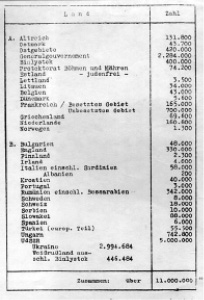Wannsee and the ‘Final Solution’
Hundreds of thousands of Jews and other people considered dangerous to the Third Reich had lost their lives at Nazi hands by the end of 1941. The events of 20 January 1942 were to be cataclysmic in sealing the fates of literally millions more Jews across Europe. On this date, fifteen Nazis met at a scenic villa next to Lake Wannsee, in a Berlin suburb, to discuss the so-called Jewish question.
The meeting was chaired by Reinhard Heydrich of the SS. Hermann Göring, Hitler’s deputy, had relayed an order to Heydrich in the summer of 1941 to ‘make all necessary organizational, functional and material preparations for a complete solution of the Jewish Question in the German sphere of influence in Europe’. Total expulsion of Jews from the Reich had ceased to be realistic in September 1939, although the Madagascar plan was not formally abandoned until well into 1940. So great was the Nazi belief in a universal Jewish enemy, however, that the question of how to deal with the 11 million Jews still living in Europe remained a pressing issue, even in the midst of a war on two fronts. The meeting at Wannsee was called to coordinate preparations for a solution to this Jewish question and to clarify the task ahead.

List of Jews resident in each European country, used at the Wannsee Conference
In euphemistic language typical of the Nazi regime, Heydrich talked of ‘natural diminution’, which in real terms meant death by forced manual labour. Europe was to be ‘combed from west to east’ and deportations of Jews to work in labour columns were to be strategically planned. Those Jews who did not perish as a result of harsh physical work would have to be ‘dealt with appropriately, because otherwise, by natural selection, they would form the germ cell of a new Jewish revival’. The implicit meaning of these words was that if slave labour and insufficient food rations did not kill the strongest Jews, they would have to be murdered by alternative means in purpose-built extermination centres. This was to be the Endlösung: the ‘Final Solution’ of the Jewish question in Europe.
Mass murder had already been taking place for several months at the hands of the Einsatzgruppen and in December 1941, gas was used to kill Jews at Chelmno, in northern Poland. Now, the means to coordinating the annihilation of all Europe’s Jews were discussed down to the minutiae. Heydrich listed the number of Jews resident in each European country and much attention was given to where different categories of Jews and Mischlinge should be deported, based on their blood status as determined by the Nuremberg Laws. Sterilization was proposed as an alternative to deportation for some first degree Mischlinge.
Since the creation of Dachau in 1933, concentration camps had been established throughout the Third Reich and Nazi-occupied territories. Conditions were intentionally punitive and many inmates did not survive their incarceration, but until the end of 1941 none of these camps was purposely designed to facilitate the murder of human beings on an industrial scale. By January 1942, however, Chelmno was already operational as a killing centre and further extermination camps were under construction at other locations in Poland: Belzec, Treblinka and Sobibor. At these camps and at Auschwitz-Birkenau, which would become the most notorious killing centre, the ‘Final Solution’ would now be executed.